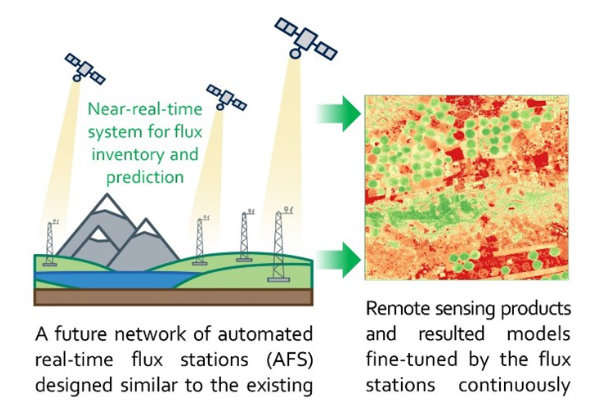Séminaire vendredi 10 septembre 2024
Direct flux measurements (GHG, ET) for immediate societal benefits: clear explanations, automated instruments, peer-to-peer data sharing, and weather station-inspired approach
 George Burba, Daugherty Water for Food Global Institute, University of Nebraska
George Burba, Daugherty Water for Food Global Institute, University of Nebraska
Vendredi 6 septembre 2024 à 13 heures, Amphi Courtois
Continental-scale research infrastructures and flux networks (e.g., AmeriFlux, AsiaFlux, ChinaFlux, ICOS, NEON, OzFlux) alongside smaller GHG flux networks and individual sites, assess CO2, CH4, and other GHG exchange, as well as evapotranspiration (ET), between ecosystems and the atmosphere. Over four decades, these flux stations have expanded to 2100+ stationary measurement points and various campaign sites. Initially for process-level studies, they now inform long-term climate modeling. These high-resolution measurements utilize cutting-edge hardware, significantly surpassing typical monitoring methods, commonly applied outside academia. Yet, despite their potential for measuring GHG emissions and ET, these applications rarely extend beyond academia. Key barriers include the perceived complexity of the method, actual complexity and cost of current instrumentation and site operation, scarcity of geographic data coverage, and a lack of a comprehensive approach focused on using direct flux measurements for immediate societal benefits.
These challenges can be addressed by:
- Simplifying explanations and offering detailed guides for method understanding.
Developing lower-cost simpler-to-use automated flux instrumentation, akin more to being a “flux sensor” than a “flux system”.
Facilitating peer-to-peer cross-sharing to reduce data gaps and station setup costs. - Adopting an approach inspired by current automated weather stations (AWS) feeding and tuning remotes sensing products and resulting in weather modeling and forecasting.
This presentation aims to catalyze discussions on utilizing flux measurements for practical decision-making applications to benefit society. It seeks to identify current needs, ideas, and examples for leveraging flux data in everyday decision contexts.
- extrait:
- lien_externe:
- titre:
- intervenant:
- date:
- kc_data:
- a:8:{i:0;s:0:"";s:4:"mode";s:0:"";s:3:"css";s:0:"";s:9:"max_width";s:0:"";s:7:"classes";s:0:"";s:9:"thumbnail";s:0:"";s:9:"collapsed";s:0:"";s:9:"optimized";s:0:"";}
- kc_raw_content:
Direct flux measurements (GHG, ET) for immediate societal benefits: clear explanations, automated instruments, peer-to-peer data sharing, and weather station-inspired approach
 George Burba, Daugherty Water for Food Global Institute, University of Nebraska
George Burba, Daugherty Water for Food Global Institute, University of NebraskaVendredi 6 septembre 2024 à 13 heures, Amphi Courtois
Continental-scale research infrastructures and flux networks (e.g., AmeriFlux, AsiaFlux, ChinaFlux, ICOS, NEON, OzFlux) alongside smaller GHG flux networks and individual sites, assess CO2, CH4, and other GHG exchange, as well as evapotranspiration (ET), between ecosystems and the atmosphere. Over four decades, these flux stations have expanded to 2100+ stationary measurement points and various campaign sites. Initially for process-level studies, they now inform long-term climate modeling. These high-resolution measurements utilize cutting-edge hardware, significantly surpassing typical monitoring methods, commonly applied outside academia. Yet, despite their potential for measuring GHG emissions and ET, these applications rarely extend beyond academia. Key barriers include the perceived complexity of the method, actual complexity and cost of current instrumentation and site operation, scarcity of geographic data coverage, and a lack of a comprehensive approach focused on using direct flux measurements for immediate societal benefits.
These challenges can be addressed by:- Simplifying explanations and offering detailed guides for method understanding.
Developing lower-cost simpler-to-use automated flux instrumentation, akin more to being a “flux sensor” than a “flux system”.
Facilitating peer-to-peer cross-sharing to reduce data gaps and station setup costs. - Adopting an approach inspired by current automated weather stations (AWS) feeding and tuning remotes sensing products and resulting in weather modeling and forecasting.
This presentation aims to catalyze discussions on utilizing flux measurements for practical decision-making applications to benefit society. It seeks to identify current needs, ideas, and examples for leveraging flux data in everyday decision contexts.
- Simplifying explanations and offering detailed guides for method understanding.
